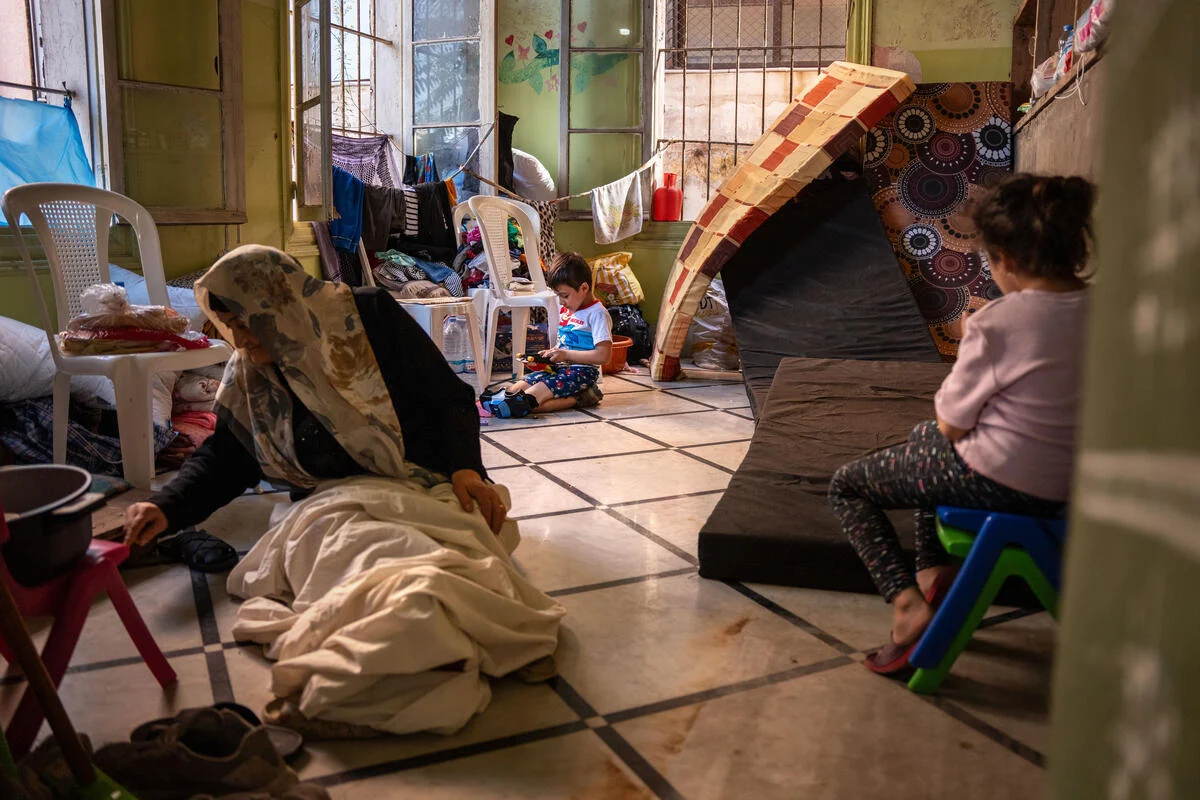“Mom, will we ever have to leave our house again? Are they still bombing? Is it near our village? Are we in danger?”
Adam, 14, and Rama, 11 keep asking these questions to their mother on a daily basis. They are constantly stressed and scared that the family would have to be displaced again.
On September 22, 2024, they were forced to leave their house in Ansar, south Lebanon, with their siblings, grandparents, and mother Reem Ismail, who only had one suitcase of clothes and no end destination. Their case was amongst the tens of thousands of families that were forcefully displaced after Israel launched multiple airstrikes towards Lebanon, declaring a two-month long war that resulted in 4,047 martyrs and 16,683 injuries, out of which 316 children were martyred and 1,456 others injured.
The Ismails were fortunate to find refuge in Halba, Akkar. They were forced to stay in the village for more than a month to stay safe, until the ceasefire agreement was announced on November 27, 2024. Their youngest, Adam and Rama, struggled greatly with this shift.
“Before arriving in Halba, we stayed for a few days in Beirut at a relative’s house. And the kids did not handle it very well”, says Reem.
“Although Rama was somehow accepting the situation, Adam was not. He was always anxious and worried about his surroundings. Rama was also very scared of the sounds of the airstrikes.”
According to the United Nations, more than 40,000 children were displaced just in the first three weeks of the war. These children were amongst the 900,000 citizens and 44,000+ families that faced internal displacement, most of whom were forced to reside in schools and open spaces. Those fortunate enough to secure available apartments often faced landlords demanding unreasonable amounts of rents, creating an additional burden on the displaced citizens that were already grappling with limited options.
With these conditions in mind, displaced children in Lebanon were “displaying alarming signs of emotional, behavioural, and physical distress,” and that the war may leave them with “severe physical wounds and deep emotional scars,” as mentioned in a report by UNICEF.
The case of children in Lebanon has also been compared to those in Gaza, as the humanitarian crisis in both countries impacted them profoundly and exposed them to serious psychological trauma, disrupted education, and limited access to basic needs.
“Although Adam and Rama found a few friends around the area we were displaced in, they were constantly uncomfortable,” Reem explains.
“They were always asking me ‘When will the war end? When are we going back to the house?’ And until now, both of them keep on wondering if the war would reoccur, and if they will have to go through the same challenges. Adam is also worried that if the war were to happen, it would target Halba.”
Displaced children’s main struggles can be noticed through the shelters they were residing in. Those who sought refuge in public schools were crammed with multiple other families, making the children’s necessities and extracurricular activities oftentimes impossible to sustain.
They were receiving food and water regularly, but other basics like hot water, medicine, mattresses, and blankets were not available for some shelters during the first month of the war.
WHO has warned that displacement is “significantly increasing public health risks” and spread of infectious diseases, in addition to vulnerable communities, such as children, having to face more barriers in accessing essential health services.
Additionally, the UNICEF highlighted that the shelters can present many health dangers to the children, especially with the falling temperatures and humidity. One of their reports indicated that “without access to safe water, children are at risk of contracting waterborne diseases like cholera or diarrhoea which, without adequate treatment, can result in dehydration and death,” in addition to reports of scabies and lice among the children.
Moreover, one of the children’s primary losses was in the field of education. With the outbreak of war, education in public schools was discontinued completely, with only a few private schools running online.
There was no internet access at the shelters, and many families just had one device that they could use. Some children in private schools were lucky enough to have this opportunity, but they were unable to benefit from it.
Most definitely, the children who were enrolled in online teaching were not able to concentrate in their lessons due to the overcrowded shelters and the sounds of Israeli planes constantly flying over them. The psychological trauma that was caused by displacement leads children to constant stress and worrying, and an incapability of proper focus.
Psychologist Dr. Lea Merhi notes that “displacement usually tends to impact most those who have already been affected by the war, thus worsening the case. For children, it depends on their age and what they know of the reason for their displacement and how parents react to it, which contributes to how it will affect the child.”
Dr. Merhi adds that the long term impacts of displacement could manifest itself as a form of maladaptive resilience in the Lebanese context. She defines the term as a representation of “resilience becoming your own enemy, basically when you tolerate things that shouldn’t be there.”
In Lebanon, this can develop into a toxic cycle of striving to endure the extreme circumstances that citizens have to go through, which can ultimately take a significant physical toll on them, according to Dr. Merhi.
“Until that day, I did not visit my severely damaged house. We are currently staying at my parents’ house until the repairs are completed,” says Reem. “Adam regularly asks when we will be able to go back. ‘Do you think we will have to go through the same things again?’ He just asked me that an hour ago.”
“I sincerely hope that what happened to us in this war will never happen again,” Reem concludes, as she remembers her journey from Ansar all the way to Halba, and now back to Ansar.
Although the war has ended, the impact of displacement, loss, and destruction, will haunt Reem and her children, as part of a national experience that has now become a defining aspect in their lives, as well as those of the rest of Lebanon’s population.


